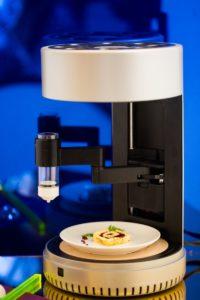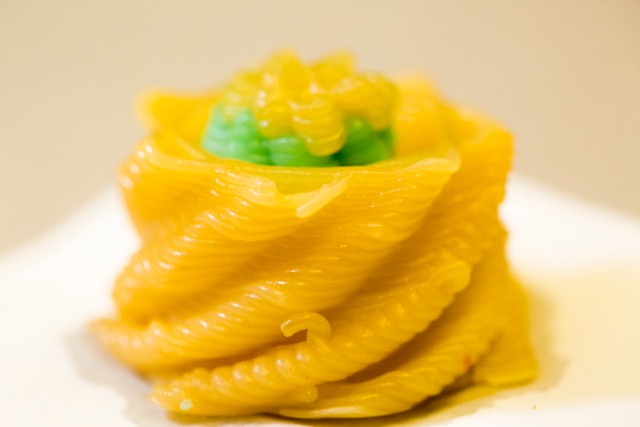Columbia Professor Hod Lipson Leads the Food 3D Printing Revolution with New Printer Prototype
There are numerous types of 3D printing technologies that are sure to make your eyes wide and mind wonder, but none of them will get your stomach rumbling like food 3D printing. This year may be finally the year that we start seeing 3D printed edible arrangements popping up in our everyday lives. Researchers have been working to print with edible cellulose-based materials, while the Magic Candy Factory has been spreading its 3D printable gummies around the world. Other companies, like Natural Machines, have taken aim at printing out entire meals with their Foodini 3D printer, while Food Ink has started a pop-up restaurant where everything, including dinner, is 3D printed.
One of the most prominent individuals pushing the idea of food 3D printing forward is 3D printing expert and Columbia University Mechanical Engineering Professor Hod Lipson, who believes that this edible type of printing could revolutionize the way we think about and prepare our food. Over the past year, Lipson and his student team have been developing a 3D food printer capable of producing edible items through computer-guided software, while pastes, gels, powders, and liquid ingredients are cooked during the process.
Although Lipson now has a keen interest in 3D printing with food, the 3D printing guru has also helped pioneer a number of critical areas in additive manufacturing, including multi-material printing, printing electromechanical systems, and bioprinting as well. In fact, it was printing with biomaterials that led the professor to his excitement for food printing. According to Lipson, 3D food printers won’t be the end-all solution for our nutritional needs, but there are a ton of advantages that could make this technology the next major innovation for 3D printing.
The particular printer being touted by Lipson was created by Drim Stokhuijzen, an industrial design graduate student visiting from Delft University of Technology in the Netherlands, and Jerson Mezquita, an undergraduate student from SUNY Maritime and research associate in Lipson’s Creative Machines Lab (CML). Although the prototype printer isn’t consumer-ready quite yet, it has a modern aesthetic fit for any 21st century kitchen. Thus far, the biggest challenge for Lipson and his team, which also includes Columbia PhD student Joni Mici and undergrad Yadir Lakehal, has been getting their prototype to cook the food after extrusion.“Food printers are not meant to replace conventional cooking—they won’t solve all of our nutritional needs, nor cook everything we should eat. But they will produce an infinite variety of customized fresh, nutritional foods on demand, transforming digital recipes and basic ingredients supplied in frozen cartridges into healthy dishes that can supplement our daily intake. I think this is the missing link that will bring the benefits of personalized data-driven health to our kitchen tables—it’s the ‘killer app’ of 3D printing,” says Lipson.
According to Lipson, this is something that he and his team should be able to accomplish by the end of this summer. It isn’t just a high-temp heated print bed they’re trying to develop, instead the printer will be able to cook various ingredients at different temperatures and durations. This component will be controlled by a unique software program that is currently being developed by Columbia Computer Science Professor Eitan Grinspun. In addition, Lipson’s team also hopes to have the printer extruding faster and more accurately by the year’s end.
In order to expand the number of materials that can be utilized , the team has collaborated with the New York City-based International Culinary Center (ICC), a renowned culinary school. Combining the culinary knowledge of the ICC with the technical prowess of Lipson’s CML, the two institutions are working in tandem to create newfound novel textures, combinations, and spatial arrangements of basic food ingredients.
Outside of the prototype they’ve been developing this year, Lipson also offered an undergraduate course at Columbia on digital manufacturing, which put 32 students up to the task of working with food 3D printers. All in all, Lipson’s work can potentially disrupt the way we consume and customize our food, whether it be through controlling our caloric and nutritional intake or creating fascinating new types of edible arrangements.“We’ve already seen that putting our technology into the hands of chefs has enabled them to create all kinds of things that we’ve never seen before, that we’ve never tried. This is just a glimpse of the future and what lies ahead,” Lipson said.
Discuss further in the Columbia 3D Food Printer forum over at 3DPB.com.
[Source: Columbia Engineering]Subscribe to Our Email Newsletter
Stay up-to-date on all the latest news from the 3D printing industry and receive information and offers from third party vendors.
Print Services
You May Also Like
New Business: Temporary, Migratory, & Modular 3D Printed Architecture
If we look at potentially emerging 3D printing businesses, then architecture has not been fully explored. Yes, there is a lot of house 3D printing going on worldwide. From deployable...
3D Printing News Briefs, April 19, 2025: Material Extrusion Standard, Metal Powder, & More
In today’s 3D Printing News Briefs, we’re covering a proposed standard for material extrusion, before moving on to business and metal powder. We’ll end with a commercial store’s robotic 3D...
Japan Unveils World’s First 3D Printed Train Station
Japan is now home to what we believe is the world’s first train station built with 3D printing technology. Located in Arida City, just south of Osaka, the new Hatsushima...
restor3d Raises $38M to Expand 3D Printed Orthopedic Implants
Backed by $38 million in new funding, restor3d is pushing ahead with the launch of four personalized implant lines, set to roll out in 2025 and 2026. This latest venture...




























